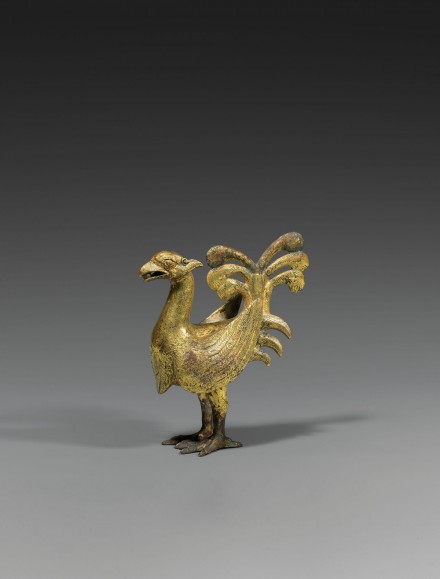J.J. Lally & Co., Oriental Art / New York City, New York
MenuPast Exhibition
Ancient Chinese Bronzes
March 19 - April 9, 2011

20.
A GILT BRONZE FIGURE OF A PHOENIX
Western Han Dynasty (206 B.C. – A.D. 8)
solid cast and with finely engraved linear detailing, the mythical bird shown standing with wings folded and head erect, holding a ‘pearl’ in its beak, its large tail cast as six plumes arrayed symmetrically and fanned out above six shorter tail feathers curled down in matching groups of three on each side, and with a pointed tuft of feathers in front extending down from the rounded chest, the head with feather-tufts sweeping back on each side behind the large staring eyes which are surmounted by curling eyebrows, and with a small circular recess on top of the head, the powerful legs ending in large talons and the surface embellished with incised stylized feather markings and other linear detailing including numerous small circles and scroll motifs, the gilding well preserved and with widely scattered bright green and red surface patination.
Height 4 11⁄16 inches (11.9 cm)
Han gilt bronze animal sculptures are extremely rare. A free-standing small gilt bronze bird with high plumed tail and similar engraved details is illustrated by Lefebvre d’Argencé, (ed.) in Chinese, Korean and Japanese Sculpture: The Avery Brundage Collection, Asian Art Museum of San Francisco, Tokyo, 1974, pp. 60-61, no. 16, where the author cites another example unearthed from a Han dynasty tomb in Ding county, Hebei province, published in Wenwu, 1964, No. 12, pl. 1-3.
A less elaborately detailed gilt bronze phoenix-finial excavated in 1980 at Lintong county, Shaanxi province, less than one kilometer north of the tomb of Qin Shihuangdi, was included in the traveling exhibition which toured Japan in 1994-95 and is illustrated in the Setagaya Museum of Art catalogue, Shin no Shikōtei to sono jidaiten (Exhibition of the Archaeological Relics of the Emperor Qin Shihuang), Tokyo, 1994, no. 115. The same gilt bronze phoenix is illustrated by Li in Eternal China: Splendors from the First Dynasties, Dayton, 1998, pp. 66-67, no. 5.
A gilt bronze vessel made in the form of two cups joined by a phoenix was discovered in 1968 at Mancheng, Hebei province, in the tomb of princess Dou Wan, the wife of prince Liu Sheng (d. 113 B.C.), ruler of the Western Han kingdom of Zhongshan and a son of the emperor, and a phoenix-form bronze lamp was found in the same tomb. See the excavation report entitled Mancheng Han mu fajue baogao (Excavation of the Han Tombs at Man-ch’eng), Beijing 1980, Vol. II, col. pls. XXIV and XXV. Both of those Han phoenix-bird objects have been widely published and exhibited since their discovery and can be found in many different publications in English and Chinese.
Compare also the group of four small gilt bronze animals discovered in 1974 in a Han dynasty tomb at Yanshi county, Henan, and now in the Henan Provincial Museum, illustrated in the catalogue of the special exhibition shown at the Empress Place, Singapore, 1990-91, Treasures from the Han, Singapore, 1990, p. 69.
西漢 鎏金銅鳳凰
高 11.9 厘米
20.
A GILT BRONZE FIGURE OF A PHOENIX
Western Han Dynasty (206 B.C. – A.D. 8)
Height 4 11⁄16 inches (11.9 cm)